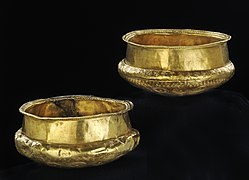Gold find from Boeslunde

The gold discovery made in 2015 by Boeslunde on the Danish island of Zealand consists of around 2000 spirals of thin, flattened gold wire with a maximum length of 3.0 cm, which were made between 900 and 700 BC. Originated during the Bronze Age .
The archaeologists initially found only a few spirals, later there were more with a total weight of between 200 and 300 grams. Two gold-plated needles were also found to help date the spirals. Many spirals appear to have been buried in a lined wooden box. They were found as lumps, while bundles of three and four pieces were found a few meters away. Birch pitch flakes were found in the spiral lump as evidence that food had been stuck in a wooden box with a bark lid.
Some of the greatest gold finds of the Nordic Bronze Age were made near Boeslunde. Years ago amateur archaeologists discovered four heavy gold arm rings, so-called oath rings, in the region . Six other heavy oath rings were found on the site. As early as the 19th century, farmers found six gold vessels from the same period with a total weight of one kilogram on two occasions (1842 and 1874) at Borgbjerg, about 500 m away .
- Gold find from Boeslunde
Nothing comparable from the Bronze Age can be proven for the spirals so far. The experts aren't sure what they were used for, but suspect they could have been part of a ceremonial robe or headdress that reflected sunlight.
literature
- HG Broholm: The Midskov find , Acta Arch. (Copenhagen), 19, 1948, pp. 189-204
- F. Horst: Young Bronze Age cult sites in the Nordic cultural area. in: Schlette / Kaufmann (ed.) 1989, pp. 219–224
- Karsten Kjer Michaelsen: Politics bog om Danmarks oldtid . Copenhagen 2002 ISBN 87-567-6458-8 , p. 184
- Andrea Stapel: Bronze Age landfills in the settlement area. Dissertation, Waxmann, 1999, ISBN 3893257357



